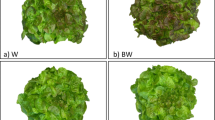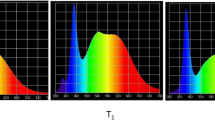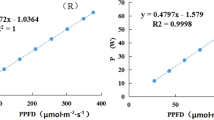Abstract
Leafy vegetables, including lettuce (Lactuca sativa L.), are considered to be healthy due to their high content of fiber, folate, carotenoids, phenolic and antioxidant compounds, minerals, and vitamins A, C, and K. Recently, LEDs are being used extensively as a supplementary light source in indoor agriculture due to the economical and physiological advantages that this artificial illumination offers compared to traditional fluorescence illumination. In this work, two commercially important lettuce varieties, Batavia Lettony (green leaves) and Batavia Diablotin (red leaves), were used to study the impact of LEDs (white and red–blue lights) and fluorescent illumination on their quality and health properties. Changes in the photosynthetic photon flux density from 250 to 400 µmol m−2 s−1 of fluorescent light increased growth parameters (leaf number, fresh and dry weight, and percentage of dry matter) of B. Lettony plants. We observed a positive impact of red–blue LED illumination on growth parameters analyzed in B. Diablotin plants compared to plants grown under fluorescent light at 250 µmol m−2 s−1. Leaf texture significantly increased in B. Lettony plants grown under 400 µmol m−2 s−1 fluorescent and LED illumination compared to that of plants grown under 250 µmol m−2 s−1 fluorescent light. This variable was only increased under red–blue LED illumination in B. Diablotin plants. Accumulation of bioactive compounds, such as anthocyanins and vitamin C, was higher in B. Diablotin plants grown under 250 µmol m−2 s−1 fluorescent light. Nutrient content in the foliar part was not modified under the light conditions used, except the Ca2+ content of B. Lettony plants grown under PPFD 400 µmol m−2 s−1 fluorescent light. Catalase (CAT) and peroxidase (POX) activities were differentially modified by light conditions in B. Lettony plants. However, POX activity was only modified in response to light conditions in B. Diablotin plants. Thus, this study demonstrates that LEDs could be used as an alternative to produce food under sustainable conditions. In this sense, although several horticultural studies have been conducted to establish the effectiveness of LEDs in lettuce growth, additional investigations are necessary to determine the optimal conditions for the use of LEDs to promote lettuce production and the accumulation of beneficial components, such as vitamins, minerals, fiber, and antioxidant compounds.





Similar content being viewed by others
References
Aćamović-Djoković G, Pavlović R, Mladenović J, Djurić M (2011) Vitamin C content of different types of lettuce varieties. Acta Agriculturae Serbica http://www.bms.ns.ac.rs/bmseng101.htm
Aebi H (1984) Catalase in vitro. Methods Enzymol 105:121–126
Amoozgar A, Mohammadi A, Sabzalian MR (2017) Impact of light-emitting diode irradiation on photosynthesis, phytochemical composition and mineral element content of lettuce cv. Grizzly. Photosynthetica 55:85–95. https://doi.org/10.1007/s11099-016-0216-8
Bariola PA, MacIntosh GC, Green PJ (1999) Regulation of S-like ribonuclease levels in Arabidopsis: antisense inhibition of RNS1 or RNS2 elevates anthocyanin accumulation. Plant Physiol 119:331–342
Baslam M, Pascual I, Sánchez-Díaz M, Erro J, García-Mina JM, Goicoechea N (2011) Improvement of nutritional quality of greenhouse-grown lettuce by Arbuscular Mycorrhizal fungi is conditioned by the source of phosphorus nutrition. J Agric Food Chem 59:11129–11140
Baslam M, Esteban R, García-Plazaola JI, Goicoechea N (2013) Effectiveness of arbuscular mycorrhizal fungi (AMF) for inducing the accumulation of major carotenoids, chlorophylls and tocopherol in green and red leaf lettuces. Appl Microbiol Biotechnol 97:3119–3128
Boo HO, Heo BG, Gorinstein S, Chon SU (2011) Positive effects of temperature and growth conditions on enzymatic and antioxidant status in lettuce plants. Plant Sci 181:479–484
Bradford MM (1976) A rapid sensitive method for the quantification of microgram quantities of protein utilising the principle of protein-dye binding. Anal Biochem 72:248–254
Bunning ML, Kendall PA, Stone MB, Stonaker FH, Stushnoff C (2010) Effects of seasonal variation on sensory properties and total phenolic content of 5 lettuce cultivars. J Food Sci 75:156–161
Camejo D, Jimenez A, Palma JM, Sevilla F (2015) Proteomic identification of mitochondrial carbonylated proteins in two maturation stages of pepper fruits. Proteomics 15:2634–2642
Cheng DM, Pogrebnyak N, Kuhn P, Krueger CG, Johnson WD, Raskin I (2014) Development and phytochemical characterization of high polyphenol red lettuce with anti-diabetic properties. PLoS ONE 9:e915712014
Chon S-U, Boo H-O, Heo B-G, Gorinstein S (2012) Anthocyanin content and the activities of polyphenol oxidase, peroxidase and phenylalanine ammonia-lyase in lettuce cultivars. Int J Food Sci Nutr 63:45–48
Choudhury FK, Rivero RM, Blumwald E, Mittler R (2017) Reactive oxygen species, abiotic stress and stress combination. Plant J 90:856–867
Darko E, Heydarizadeh P, Schoefs B, Sabzalian MR (2014) Photosynthesis under artificial light: the shift in primary and secondary metabolism. Philos Trans R Soc Lond. https://doi.org/10.1098/rstb.2013.0243
Dietz KJ (2003) Redox control, redox signalling and redox homeostasis in plant cells. Int Rev Cytol 228:141–193
Fu Y, Li H-Y, Yu J, Liu H, Cao ZY, Manukovsky NS, Liu H (2017) Interaction effects of light intensity and nitrogen concentration on growth, photosynthetic characteristics and quality of lettuce (Lactuca sativa L. Var. youmaicai). Sci Hortic 214:51–57
Giannakourou MC, Taoukis PS (2003) Kinetics modeling of Vitamin C loss in frozen green vegetables under variable storage conditions. Food Chem 83:33–41
Gillespie KM, Ainsworth EA (2007) Measurement of reduced, oxidized and total ascorbate content in plants. Nat Protoc 2:871–874
Halder M, Joardar JC, Amin MdS (2015) Potassium, calcium and sodium distribution in different part of common vegetable plants grown under field condition. Res J Soil Biol 7:91–97
Han T, Vaganov V, Cao S, Li Q, Ling L, Cheng X, Peng L, Zhang C, Yakovlev AN, Zhong Y, Tu M (2017) Improving “color rendering” of LED lighting for the growth of lettuce. Sci Rep 7:45944. https://doi.org/10.1038/srep45944
Hepler PK (2005) Calcium: a central regulator of plant growth and development. Plant Cell 17:2142–2155
Hogewoning SW, Trouwborst G, Maljaars H, Poorter H, van Ieperen W, Harbinson J (2010) Blue light dose-responses of leaf photosynthesis, morphology, and chemical composition of Cucumis sativus grown under different combinations of red and blue light. J Exp Bot 61:3107–3117
Hu Y-Q, Liu S, Yuan H-M, Li J, Yan D-W, Zhang J-F, Lu Y-T (2010) Functional comparison of catalase genes in the elimination of photorespiratory H2O2 using promoter- and 3-untranslated region exchange experiments in the Arabidopsis cat2 photorespiratory mutant. Plant Cell Environ 33:1656–1670
Johkan M, Shoji K, Goto F, Hashida S-N, Yoshihara T (2010) Blue light-emitting diode light irradiation of seedlings improves seedling quality and growth after transplanting in red leaf lettuce. HortScience 45:1809–1814
Kang WH, Zhang F, Lee JW, Son JE (2016) Improvement of canopy light distribution, photosynthesis, and growth of lettuce (Lactuca sativa L.) in plant factory conditions by using filters to diffuse light from LEDs. Korean J Hortic Sci Technol 34:84–93
Kim HH, Goins GD, Wheeler RM, Sager JC (2004) Green-light supplementation for enhanced lettuce growth under red-and blue light-emitting diodes. HortScience 39:1617–1622
Kim MJ, Moon Y, Tou JC, Mou B, Waterland NL (2016) Nutritional value, bioactive compounds and health benefits of lettuce (Lactuca sativa L.). J Food Compos Anal 49:19–34
Kozai T (2013) Resource use efficiency of closed plant production system with artificial light: concept, estimation and application to plant factory. Proc Jpn Acad Ser B Phys Biol Sci 89:447–461
Kris-Etherton PM, Harris WS, Appel LJ (2002) Fish consumption, fish oil, omega-3 fatty acids, and cardiovascular disease. Circulation 106:2747–2757
Li Q, Kubota C (2009) Effects of supplemental light quality on growth and phytochemicals of baby leaf lettuce. Environ Exp Bot 67:59–64
Li Z, Zhao X, Sandhu AK, Gu L (2010) Effects of exogenous abscisic acid on yield, antioxidant capacities, and phytochemical contents of greenhouse grown lettuces. J Agric Food Chem 58:6503–6509
Lichtenthaler HK, Buschmann C (2001) Chlorophylls and Carotenoids: measurement and Characterization by UV–VIS Spectroscopy. Curr Protoc Food Anal Chem. https://doi.org/10.1002/0471142913.faf0403s01
Lin K-H, Huang M-Y, Huang W-D, Hsu M-H, Yang Z-W, Yang C-M (2013) The effects of red, blue, and white light-emitting diodes on the growth, development, and edible quality of hydroponically grown lettuce (Lactuca sativa L. var. capitata). Sci Hortic 150:86–91
Llorach R, Martínez-Sánchez A, Tomás-Barberán FA, Gil MI, Ferreres F (2008) Characterisation of polyphenols and antioxidant properties of five lettuce varieties and escarole. Food Chem 108:1028–1038
López A, García-Alonso J, Fenoll J, Hellín P, Flores P (2014) Chemical composition and antioxidant capacity of lettuce: comparative study of regular-sized (Romaine) and baby sized (Little Gem and Mini Romaine) types. J Food Compos Anal 33:39–48
Mampholo BM, Maboko MM, Soundy P, Sivakumar D (2016) Phytochemicals and overall quality of leafy lettuce (Lactuca sativa L.) varieties grown in closed hydroponic system. J Food Qual 39:805–815
Massa GD, Emmerich JC, Morrow RC, Bourget CM, Mitchell CA (2006) Plant growth lighting for space life support: a review. Gravit Space Biol 19:19–30
Mhamdi A, Queval G, Chaouch S, Vanderauwera S, Breusegem FV, Noctor G (2010) Catalase function in plants: a focus on Arabidopsis mutants as stress-mimic models. J Exp Bot 61:4197–4220
Mika A, Lüthje S (2003) Properties of guaiacol peroxidase activities isolated from corn root plasma membranes. Plant Physiol 132:1489–1498
Mittler R (2002) Oxidative stress, antioxidants and stress tolerance. Trends Plant Sci 7:405–410
Miyagi A, Uchimiya H, Kawai-Yamada M (2017) Synergistic effects of light quality, carbon dioxide and nutrients on metabolite compositions of head lettuce under artificial growth conditions mimicking a plant Factory. Food Chem 218:561–568
Muneer S, Kim EJ, Park JS, Lee JH (2014) Influence of green, red and blue light emitting diodes on multiprotein complex proteins and photosynthetic activity under different light intensities in lettuce leaves (Lactuca sativa L.). Int J Mol Sci 15:4657–4670
Neill SO, Gould KS (2003) Anthocyanins in leaves: light attenuators or antioxidants? Funct Plant Biol 30:865–873
Nelson JA, Bugbee B (2014) Economic analysis of greenhouse lighting: light emitting diodes vs. high intensity discharge fixtures. PLoS ONE 9:e99010
Oh M-M, Carey EE, Rajashekar CB (2009) Environmental stresses induce health-promoting phytochemicals in lettuce. Plant Physiol Biochem 47:578–583
Olle M, Viršilė A (2013) The effects of light-emitting diode lighting on greenhouse plant growth and quality. Agric Food Sci 22:223–234
Ortiz-Espín A, Locato V, Camejo D, Schiermeyer A, De Gara L, Sevilla F, Jimenéz A (2015) Over-expression of Trxo1 increases the viability of tobacco BY-2 cells under H2O2 treatment. Ann Bot. https://doi.org/10.1093/aob/mcv076
Paradiso R, Buonomo R, De Micco V, Aronne G, Palermo M, Barbieri G, De Pascale S (2012) Soybean cultivar selection for Bioregenerative Life Support Systems (BLSSs). Hydroponic cultivation. Adv Space Res 50:1501–1511
Park YG, Park JE, Hwang SJ, Jeong BR (2012) Light source and CO2 concentration affect growth and anthocyanin content of lettuce under controlled environment. Hortic Environ Biotechnol 53:460–466
Pinho P, Jokinen K, Halonen L (2016) The influence of the LED light spectrum on the growth and nutrient uptake of hydroponically grown lettuce. Light Res Technol. https://doi.org/10.1177/1477153516642269
Piovene C, Orsini F, Bosi S, Sanoubar R, Bregola V, Dinelli G, Gianquinto G (2015) Optimal red:blue ratio in led lighting for nutraceutical indoor horticulture. Sci Hortic 193:202–208
Queval G, Issakidis-Bourguet E, Hoeberichts FA, Vandorpe M, Gakiere B, Vanacker H, Miginiac-Maslow M, Van Breusegem F, Noctor G (2007) Conditional oxidative stress responses in the Arabidopsis photorespiratory mutant cat2 demonstrate that redox state is a key modulator of day length-dependent gene expression, and define photoperiod as a crucial factor in the regulation of H2O2-induced cell death. Plant J 52:640–657
Rahman A, Nahar K, Hasanuzzaman M, Fujita M (2016) Calcium supplementation improves Na+/K+ ratio, antioxidant defense and glyoxalase systems in salt-stressed rice seedlings. Front Plant Sci 7:609. https://doi.org/10.3389/fpls.2016.00609
Romani A, Pinelli P, Galardi C, Sani G, Cimato A, Heimler D (2002) Polyphenols in greenhouse and open-air-grown lettuce. Food Chem 79:337–342
Sabzalian MR, Heydarizadeh P, Zahedi M, Boroomand A, Agharokh M, Sahba MR, Schoefs B (2014) High performance of vegetables, flowers, and medicinal plants in a red–blue LED incubator for indoor plant production. Agron Sustain Dev 34:879–886
Samuolienė G, Brazaityte A, Sirtautas R, Viršile A, Sakalauskaite J, Sakalauskiene S, Duchovskis P (2013) LED illumination affects bioactive compounds in romaine baby leaf lettuce. J Sci Food Agric 93:3286–3291
Shen E, Hu J, Patel M (2014) Energy and visual comfort analysis of lighting and daylight control strategies. Build Environ 78:155–170
Smirnoff N (2000) Ascorbic acid: metabolism and functions of a multi-facetted molecule. Curr Opin Plant Biol 3:229–235
Son K-H, Oh M-M (2013) Leaf shape, growth, and antioxidant phenolic compounds of two lettuce cultivars grown under various combinations of blue and red light-emitting diodes. HortScience 48:988–995
Son K-H, Jeon Y-M, Oh M-M (2016) Application of supplementary white and pulsed light-emitting diodes to lettuce grown in a plant factory with artificial lighting. Hortic Environ Biotechnol 57:560–572
Stutte GW, Edney S, Skerritt T (2009) Photoregulation of bioprotectant content of red leaf lettuce with light-emitting diodes. HortScience 44:79–82
Walton PA, Pizzitelli M (2012) Effects of peroxisomal catalase inhibition on mitochondrial function. Front Physiol 3:108
Wojciechowska R, Kołton A, Długosz-Grochowska O, Knop E (2016) Nitrate content in Valerianella locusta L. plants is affected by supplemental LED lighting. Sci Hortic 211:179–186
Xu F, Cao S, Shi L, Chen W, Su X, Yang Z (2014) Blue light irradiation affects anthocyanin content and enzyme activities involved in postharvest strawberry fruit. J Agric Food Chem 62:4778–4783
Zhou Y, Zhang Y-Y, Zhao X, Yu H-J, Shi K, Yu JQ (2009) Impact of light variation on development of photoprotection, antioxidants, and nutritional value in Lactuca sativa L. J Agric Food Chem 57:5494–5500
Zhou W, Liu W, Yang Q (2013) Reducing nitrate concentration in lettuce by elongated lighting delivered by red and blue LEDs before harvest. J Plant Nutr 36:481–490
Zhu H, Zhang TJ, Zhang P, Peng CL (2016) Pigment patterns and photoprotection of anthocyanins in the young leaves of four dominant subtropical forest tree species in two successional stages under contrasting light conditions. Tree Physiol 36:1092–1104
Acknowledgements
This work was supported by a Ministry of Science and Technology (Grant number RETOS-Collaboration Project (RTC-2016-4827-2)-Spain).
Author information
Authors and Affiliations
Contributions
DC and AF these authors contributed equally to this manuscript. Investigation, DC, AF, TCM; Data analysis, DC, AF Funding acquisition and Project administration, VM; Writing-original draft, DC; Writing-review, MCP, RMR.
Corresponding author
Ethics declarations
Conflict of interest
All authors declare that they have no conflict of interest.
Additional information
Communicated by Myung-Min Oh.
Publisher's Note
Springer Nature remains neutral with regard to jurisdictional claims in published maps and institutional affiliations.
Electronic supplementary material
Below is the link to the electronic supplementary material.
Rights and permissions
About this article
Cite this article
Camejo, D., Frutos, A., Mestre, T.C. et al. Artificial light impacts the physical and nutritional quality of lettuce plants. Hortic. Environ. Biotechnol. 61, 69–82 (2020). https://doi.org/10.1007/s13580-019-00191-z
Received:
Revised:
Accepted:
Published:
Issue Date:
DOI: https://doi.org/10.1007/s13580-019-00191-z




